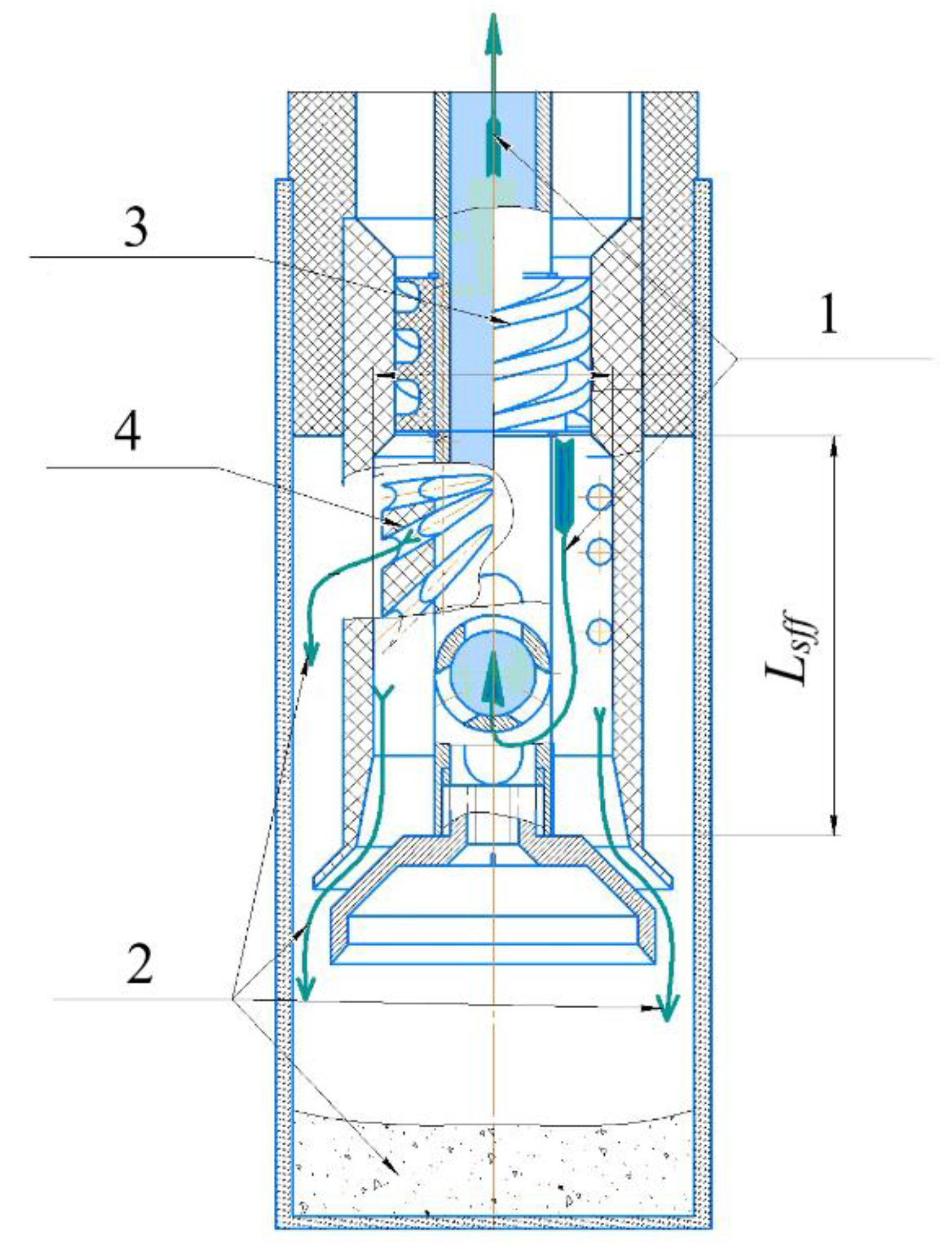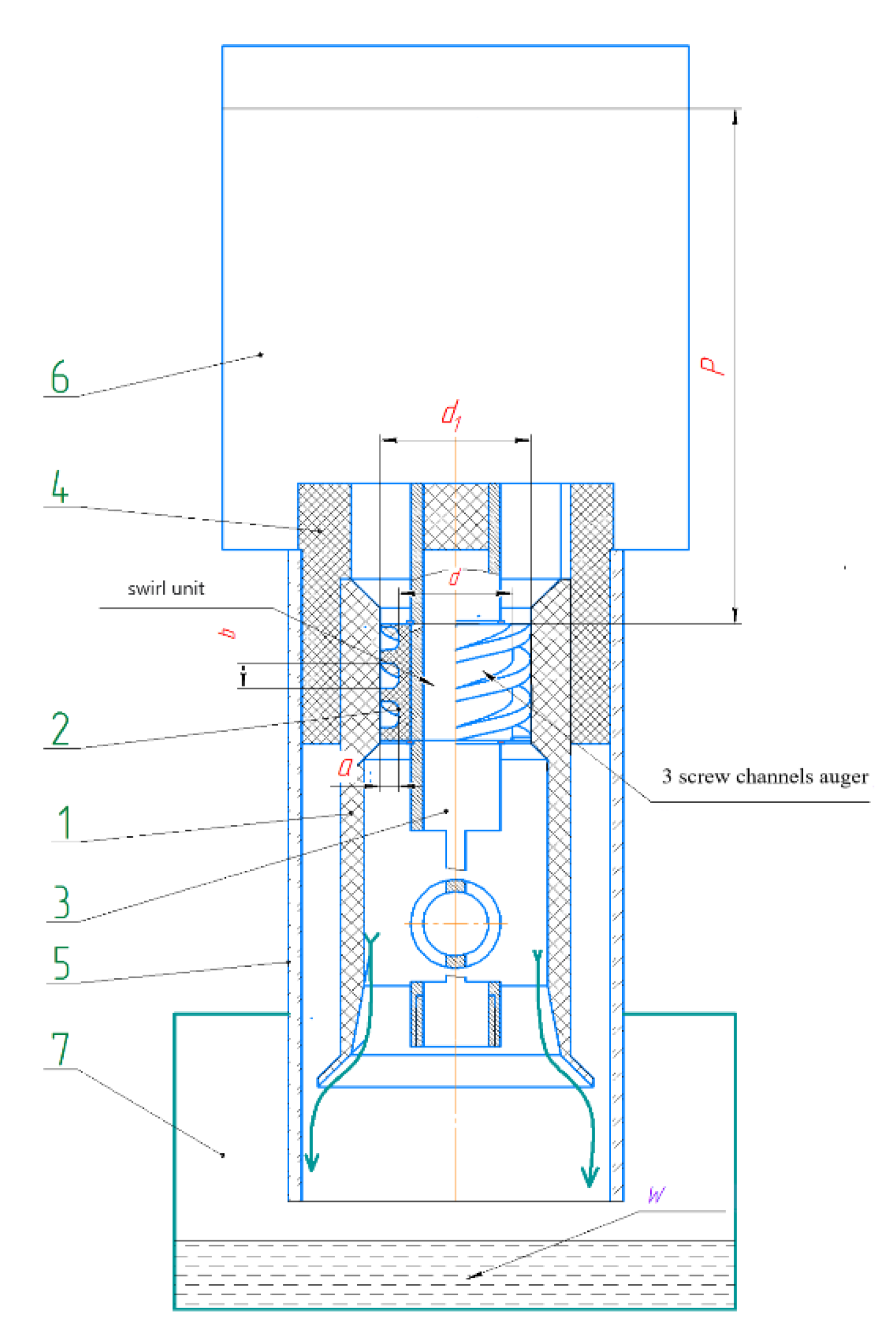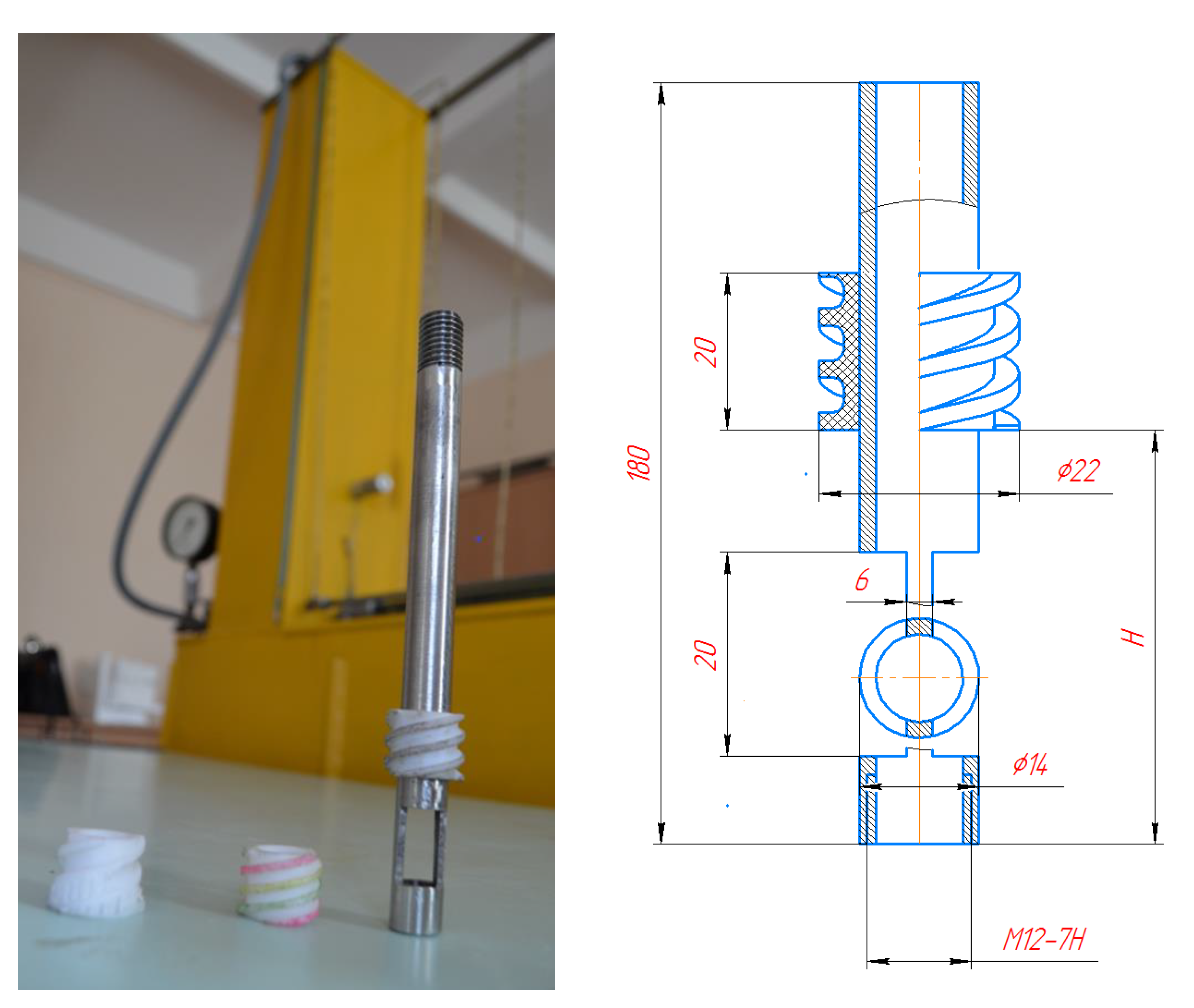RETRACTED: Development and Testing of a Block Hydrocyclone
Abstract
1. Introduction
2. Materials and Methods
2.1. Mathematical Models
- Lsff—length of swirling fluid flow, mm;
- 1—the direction of fluid movement;
- 2—the direction of movement and location of particles of mechanical impurities in the sump;
- 3—fluid flow swirling unit (auger);
- 4—filtration unit.
2.2. Area of Research
3. Results and Discussion
4. Conclusions
- -
- the average Reynolds number from 4732 to 7365 and
- -
- average flow coefficient from 0.498 to 0.619.
Author Contributions
Funding
Acknowledgments
Conflicts of Interest
References
- Macdonald, E. Handbook of Gold Exploration and Evaluation; Woodhead Publishing: Cambridge, UK, 2007; Paperback ISBN 9781845691752, ebook ISBN 9781845692544. [Google Scholar]
- Elbakian, A.; Sentyakov, B.; Bozek, P.; Kuric, I.; Sentyakov, K. Automated separation of basalt fibre and other earth resources by the means of acoustic vibrations. Acta Montan. Slovaca 2018, 23, 271–281. [Google Scholar]
- Alireza, B. Essentials of Oil and Gas Utilities: Process Design, Equipment, and Operations; Gulf Professional Publishing: Woburn, MA, USA, 2016; Paperback ISBN 9780128030882, ebook ISBN 9780128030899. [Google Scholar]
- Gonera, H.; Mii, T. The application of the bivariate normal distribution of macro stickies particles to reinterpret efficiency estimation of their separation in the hydrocyclones. [Zastosowanie statystycznego dwuwymiarowego rozkfadu własności cząstek kleistych do reinterpretacji oceny skuteczności ich separacji w hydrocyklonach]. Prz. Pap. 2007, 63, 351–358. [Google Scholar]
- Shan, Y.; Li, Y. Study on the prediction of hydrocyclone separation performance with RSM model. Pet. Refin. Eng. 2005, 35, 18–21. [Google Scholar]
- Stewart, M.; Arnold, K. Emulsions and Oil Treating Equipment: Selection, Sizing and Troubleshooting; Gulf Professional Publishing: Woburn, MA, USA, 2008; Hardcover ISBN 9780750689700, ebook ISBN 9780080559025. [Google Scholar]
- Krishna, R.; Sie, S.T. Design and scale-up of the Fischer-Tropsch bubble column slurry reactor. Fuel Process. Technol. 2000, 64, 73–105. [Google Scholar] [CrossRef]
- Krishna, R. A scale-up strategy for a commercial scale bubble column slurry reactor for Fischer-Tropsch synthesis. Oil Gas Sci. Technol. Rev. IFP Energ. Nouv. 2000, 55, 359–393. [Google Scholar] [CrossRef][Green Version]
- Kulkarni, A.A.; Joshi, J.B. Bubble formation and bubble rise velocity in gas-liquid systems: A review. Ind. Eng. Chem. Res. 2005, 44, 5873–5931. [Google Scholar] [CrossRef]
- Tailleur, R.; Salva, G.; Garcia, G. Hydrotreated-LCO oxidation in a transported slurry reactor-hydrocyclon system reactor for a low emission fuel oil production: I Kinetic of reactions. Fuel 2009, 88, 744–755. [Google Scholar] [CrossRef]
- Tailleur, R.; Garcia, G.; Salva, A. Hydrotreated-LCO oxidation in a transport reactor-hydrocyclon system for a low-emission fuel oil production. II Catalyst deactivation and simulation model. Fuel 2009, 88, 1109–1119. [Google Scholar] [CrossRef]
- Inga, J.R.; Morsi, B.I. Effect of operating variables on the gas holdup in a large-scale slurry bubble column reactor operating with an organic liquid mixture. Ind. Eng. Chem. Res. 1999, 38, 928–937. [Google Scholar] [CrossRef]
- Fu, B.; Weinstee, H.; Bernstee, B.; Shaffer, A. Residence time distributions of recycling systems-integral equation formulation. Ind. Eng. Chem. Process. Design Dev. 1971, 10, 501–508. [Google Scholar] [CrossRef]
- Fu, C.; Lu, S.; Hsu, Y. Low emission using oxidized diesel. Chem. Eng. Sci. 2004, 59, 3021–3028. [Google Scholar] [CrossRef]
- Galiasso, T.; Roberto, E.; Casanova, C.; Pedro, O. Low emission using oxidized diesel. Int. J. Chem. React. Eng. 2007, 5, A105. [Google Scholar]
- Beno, M.; Zvoncan, M.; Kovac, M.; Peterka, J. Circular interpolation and positioning accuracy deviation measurement on five-axis machine tools with different structures. Teh. Vjesn. Tech. Gaz. 2013, 20, 479–484. [Google Scholar]
- Peterka, J.; Pokorny, P.; Vaclav, S. CAM strategies and surface accuracy. In Proceedings of the Annals of DAAAM and Proceedings, Trnava, Slovakia, 22–25 October 2008; pp. 1061–1062. [Google Scholar]
- Tutak, M.; Brodny, J.; Navickas, K. Studying the Impact of the Location of Air-Duct Lines on Methane Distribution and Concentration in Dog Headings. Acta Montan. Slovaca 2019, 24, 285–295. [Google Scholar]
- Bozek, P.; Turygin, Y. Measurement of the operating parameters and numerical analysis of the mechanical subsystem. Meas. Sci. Rev. 2014, 14, 198–203. [Google Scholar] [CrossRef]
- Bashta, T.M.; Rudnev, S.S.; Nekrasov, B.B. Hydraulics, Hydraulic Machines and Hydraulic Drives; Alliance Publishing House: Moscow, Russia, 2010; 423p, Paperback ISBN 978-5-903034-88-8. [Google Scholar]
- Smirnov, V.A.; Repko, A.V. Workpiece Temperature Variations during Flat Peripheral Grinding. Manag. Syst. Prod. Eng. 2018, 26, 93–98. [Google Scholar] [CrossRef]
- Gusev, A.A. Hydraulics. In Theory and Practice: A Textbook for Universities; Yurayt Publishing House: Moscow, Russia, 2015; p. 285, Paperback ISBN978-5-9916-3434-2. [Google Scholar]
- Ukhin, B.V.; Gusev, A.A. Hydraulics: Textbook/B. V.; Secondary Vocational Education; INFRA-M: Moscow, Russia, 2020; p. 432, Paperback ISBN 978-5-16-005536-7. [Google Scholar]
- Golubtsov, V.M. Upon pressure hydrocyclones volumetric output by sands product. Obogashchenie Rudissue 2014, 2, 15–17. [Google Scholar]
- Stumpp, A. Hydrocyclon plants for the treatment for draving lubricants. Wire World Int. 2015, 198–203. [Google Scholar]






| № Test | m2·10−3 | Liquid Flow Time, t, s | Volume Liquid, W, m3·10−3 | , m3/s·10−3 | Water Velocity, | Reynolds Number, | Coefficient Flow Rate, |
|---|---|---|---|---|---|---|---|
| The pitch of screw channels of swirler 15 mm | |||||||
| 1 | 0.0172 | 237 | 4.8 | 0.0170 | 0.98 | 4590 | 0.487 |
| 2 | 0.0172 | 76 | 1.35 | 0.0177 | 1.029 | 4819 | 0.507 |
| 3 | 0.0172 | 71 | 1.2 | 0.0169 | 0.983 | 4604 | 0.484 |
| 4 | 0.0172 | 62 | 1.1 | 0.0177 | 1.029 | 4819 | 0.507 |
| 5 | 0.0172 | 61 | 1.075 | 0.0176 | 1.023 | 4791 | 0.504 |
| 6 | 0.0172 | 61.5 | 1.12 | 0.0172 | 1.000 | 4683 | 0.493 |
| 7 | 0.0172 | 76 | 1.35 | 0.0177 | 1.029 | 4819 | 0.507 |
| Average values | 4732 | 0.498 | |||||
| The pitch of screw channels of swirler 22 mm | |||||||
| 8 | 0.027 | 62 | 2.1 | 0.0339 | 1.250 | 7325 | 0.619 |
| 9 | 0.027 | 63 | 2.175 | 0.0345 | 1.277 | 7483 | 0.623 |
| 10 | 0.027 | 61 | 2.05 | 0.0336 | 1.244 | 7289 | 0.616 |
| Average values | 7365 | 0.619 | |||||
Publisher’s Note: MDPI stays neutral with regard to jurisdictional claims in published maps and institutional affiliations. |
© 2020 by the authors. Licensee MDPI, Basel, Switzerland. This article is an open access article distributed under the terms and conditions of the Creative Commons Attribution (CC BY) license (http://creativecommons.org/licenses/by/4.0/).
Share and Cite
Repko, A.; Sága, M.; Sentyakov, B.; Sviatskii, V. RETRACTED: Development and Testing of a Block Hydrocyclone. Processes 2020, 8, 1577. https://doi.org/10.3390/pr8121577
Repko A, Sága M, Sentyakov B, Sviatskii V. RETRACTED: Development and Testing of a Block Hydrocyclone. Processes. 2020; 8(12):1577. https://doi.org/10.3390/pr8121577
Chicago/Turabian StyleRepko, Alexandr, Milan Sága, Boris Sentyakov, and Vladislav Sviatskii. 2020. "RETRACTED: Development and Testing of a Block Hydrocyclone" Processes 8, no. 12: 1577. https://doi.org/10.3390/pr8121577
APA StyleRepko, A., Sága, M., Sentyakov, B., & Sviatskii, V. (2020). RETRACTED: Development and Testing of a Block Hydrocyclone. Processes, 8(12), 1577. https://doi.org/10.3390/pr8121577





